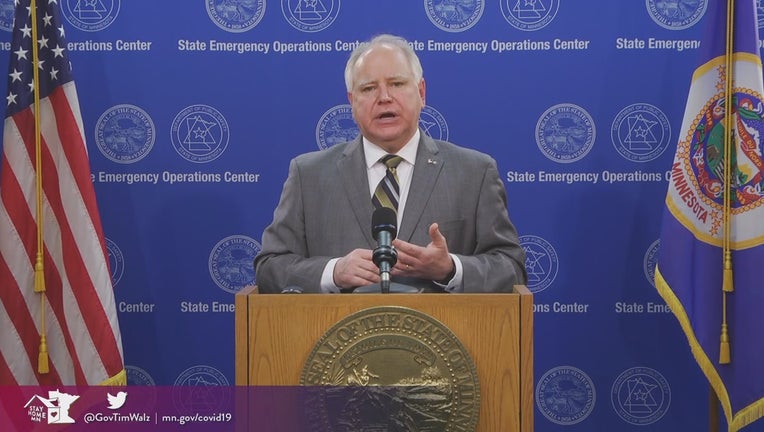Gov. Walz extends Minnesota's stay-at-home order until May 18, allows some businesses to reopen

Governor Tim Walz gives an update on COVID-19 in Minnesota on April 23, 2020. (FOX 9)
ST. PAUL, Minn. (FOX 9) - Gov. Tim Walz announced Thursday he will extend Minnesota’s stay-at-home order, which was set to expire Monday, until May 18 while allowing some businesses to reopen.
The modified executive order allows retail businesses and other non-critical businesses to resume operations with curbside pick-up and delivery beginning May 4. This includes businesses that provide home goods rental, maintenance services, repair services and pet grooming.

Gov. Walz extends stay-at-home order until May 18
Gov. Tim Walz announced Thursday he will extend the stay-at-home order.
Salons and barbershops will also be allowed to reopen, but only to sell retail products for pick-up and not to provide services.
"Under no circumstances can a customer enter a business," Economic Development Commissioner Steve Grove said. "In every place possible, we ask that they remain in their cars." He added that delivery people should not enter a person's home.
Grove said businesses must develop and publicly post a plan for how they can open safely.
Officials estimate the modified order will allow approximated 10,000 businesses to reopen and an estimated 30,000 Minnesotans to go back to work.
With the move, Walz said 82 percent of Minnesota's businesses will be allowed to open by Monday. But the economic pain has been deep: more than 584,000 Minnesotans have filed for unemployment since mid-March, 18.7 percent of the state's workforce.
Large group gatherings, in-person worship, youth sports and camps, large weddings and graduations, and routine dental care will not be allowed to reopen for the time being, Walz said.
Legislative Republicans criticized the governor and said the two-week extension of the stay-home order would be devastating to small businesses.
"The governor is asking the right questions and looking at the right data, but I'm disappointed he's not turning the dial further today," Senate Majority Leader Paul Gazelka, R-East Gull Lake, said in an emailed statement. "I think he should move further, and faster, opening businesses up again in Minnesota."
Democratic leaders said they supported the governor's decision.
Told of the GOP reaction, Walz denied that he had shifted the goalposts since issuing his original orders in mid-March. The state's confirmed cases are accelerating as Minnesota slowly increases testing, showing the peak is yet to come.
"Those who are saying we should open up all businesses tomorrow because this is not serious and we overreacted, they are wrong," Walz said.
The governor is also encouraging all Minnesotans to wear a manufactured or homemade mask at all times when they leave their homes to go any place where social distancing is difficult.
Walz emphasized that people should also continue to work from home if they are able.
“If you are already teleworking, keep doing it,” he said.
The stay-at-home order has been in effect since March 27.
"Minnesotans have saved lives and bought valuable time," Walz said

Walz to announce more reopenings Thursday
Minnesota Gov. Tim Walz said he would outline his next steps to reopen the state on Thursday just days before his stay-home order is set to expire.
TIMELINE OF MINNESOTA's COVID-19 RESPONSE
March 6: MDH confirms first case of COVID-19 in Minnesota
March 11: World Health Organization declares outbreak of COVID-19 a pandemic
March 13: Gov. Walz declares peacetime state of emergency, recommending all large gathering be canceled or postponed
March 15: MDH confirms first COVID-19 cases caused by community spread
March 17: Gov. Walz orders dine-in restaurants, bars, hair salons and other public attractions to close
March 18: All public schools in Minnesota close
March 27: Stay-at-home order goes into effect, set to expire on April 10
April 8: Gov. Walz extends stay-at-home order until May 4
April 24: Gov. Walz closes schools for remainder of academic year
April 27: Some non-essential industrial and manufacturing businesses allowed to reopen
A CALL FOR INCREASED TESTING
Throughout the stay-at-home order, Governor Walz has pushed for expanded COVID-19 testing, calling it the key to reopening businesses.
On April 22, the state struck a deal with the University of Minnesota and the Mayo Clinic to increase the testing capacity to 20,000 a day.

Minnesota launches website to show COVID-19 testing locations
As Minnesota expands COVID-19 testing, the state is launching a website for people to find testing locations.
Due to an early test kit shortage, qualifications to get tested were fairly strict, state health leaders now are encouraging health care providers to open up testing to all symptomatic patients. Week-over-week testing numbers are rising, but have fallen short of goals so far.
As of Thursday, Minnesota has reported 5,136 positive COVID-19 cases and 343 deaths.

